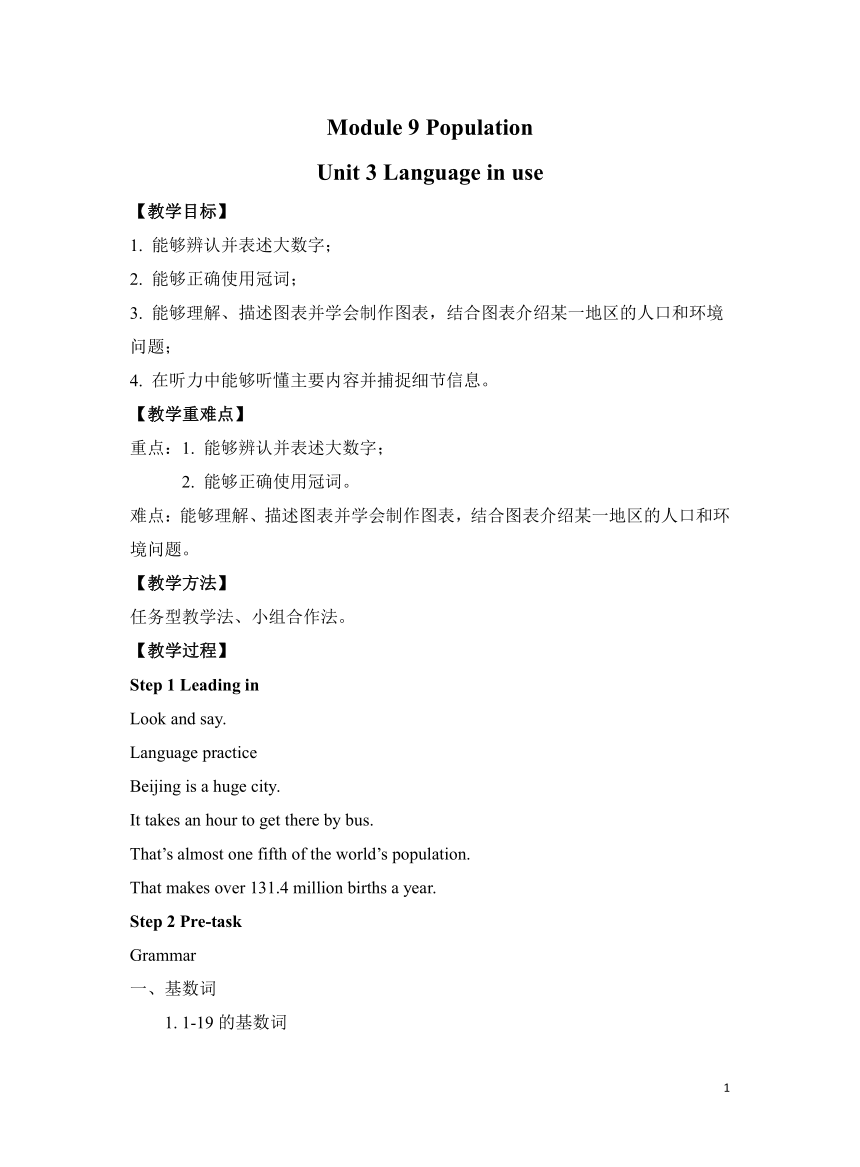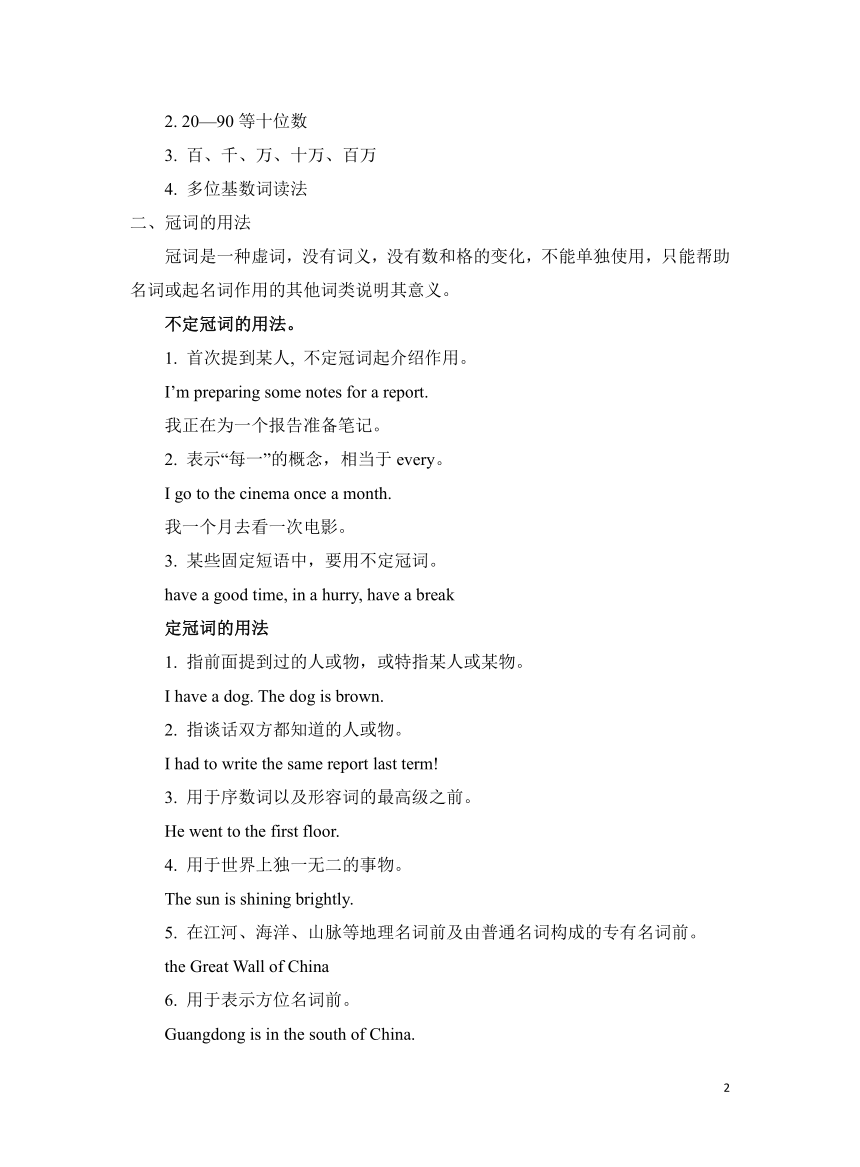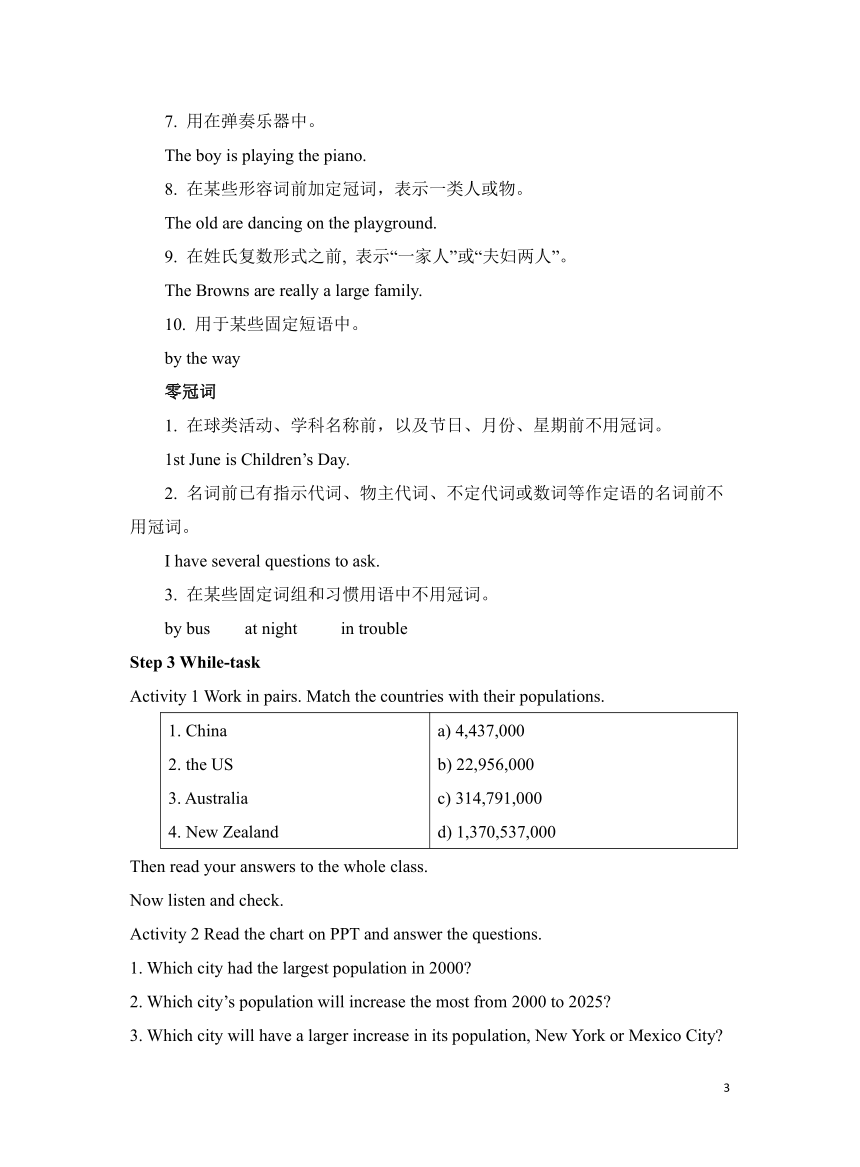Module 9 Population Unit 3 Language in use教案
文档属性
| 名称 | Module 9 Population Unit 3 Language in use教案 |

|
|
| 格式 | doc | ||
| 文件大小 | 53.5KB | ||
| 资源类型 | 教案 | ||
| 版本资源 | 外研版 | ||
| 科目 | 英语 | ||
| 更新时间 | 2023-08-30 16:24:38 | ||
图片预览



文档简介
Module 9 Population
Unit 3 Language in use
【教学目标】
1. 能够辨认并表述大数字;
2. 能够正确使用冠词;
3. 能够理解、描述图表并学会制作图表,结合图表介绍某一地区的人口和环境问题;
4. 在听力中能够听懂主要内容并捕捉细节信息。
【教学重难点】
重点:1. 能够辨认并表述大数字;
2. 能够正确使用冠词。
难点:能够理解、描述图表并学会制作图表,结合图表介绍某一地区的人口和环境问题。
【教学方法】
任务型教学法、小组合作法。
【教学过程】
Step 1 Leading in
Look and say.
Language practice
Beijing is a huge city.
It takes an hour to get there by bus.
That’s almost one fifth of the world’s population.
That makes over 131.4 million births a year.
Step 2 Pre-task
Grammar
一、基数词
1. 1-19的基数词
2. 20—90等十位数
3. 百、千、万、十万、百万
4. 多位基数词读法
二、冠词的用法
冠词是一种虚词,没有词义,没有数和格的变化,不能单独使用,只能帮助名词或起名词作用的其他词类说明其意义。
不定冠词的用法。
1. 首次提到某人, 不定冠词起介绍作用。
I’m preparing some notes for a report.
我正在为一个报告准备笔记。
2. 表示“每一”的概念,相当于every。
I go to the cinema once a month.
我一个月去看一次电影。
3. 某些固定短语中,要用不定冠词。
have a good time, in a hurry, have a break
定冠词的用法
1. 指前面提到过的人或物,或特指某人或某物。
I have a dog. The dog is brown.
2. 指谈话双方都知道的人或物。
I had to write the same report last term!
3. 用于序数词以及形容词的最高级之前。
He went to the first floor.
4. 用于世界上独一无二的事物。
The sun is shining brightly.
5. 在江河、海洋、山脉等地理名词前及由普通名词构成的专有名词前。
the Great Wall of China
6. 用于表示方位名词前。
Guangdong is in the south of China.
7. 用在弹奏乐器中。
The boy is playing the piano.
8. 在某些形容词前加定冠词,表示一类人或物。
The old are dancing on the playground.
9. 在姓氏复数形式之前, 表示“一家人”或“夫妇两人”。
The Browns are really a large family.
10. 用于某些固定短语中。
by the way
零冠词
1. 在球类活动、学科名称前,以及节日、月份、星期前不用冠词。
1st June is Children’s Day.
2. 名词前已有指示代词、物主代词、不定代词或数词等作定语的名词前不用冠词。
I have several questions to ask.
3. 在某些固定词组和习惯用语中不用冠词。
by bus at night in trouble
Step 3 While-task
Activity 1 Work in pairs. Match the countries with their populations.
1. China2. the US3. Australia4. New Zealand a) 4,437,000b) 22,956,000c) 314,791,000d) 1,370,537,000
Then read your answers to the whole class.
Now listen and check.
Activity 2 Read the chart on PPT and answer the questions.
1. Which city had the largest population in 2000
2. Which city’s population will increase the most from 2000 to 2025
3. Which city will have a larger increase in its population, New York or Mexico City
4. Which city/cities do you think will have the biggest population problem Why
Activity 3 Complete the passage with a, an or the where necessary.
Mina is (1) ____ eighteen-year-old girl. She’s got (2) ____ brother and (3) ____ sister. Mina is (4) ____ oldest child in (5) _____ family. She lives in (6) ____ very big city. She has (7) ___ job in (8) ____ hotel. She hopes that one day she will have (9) ___ chance to go to (10) ___ college.
Activity 4 Complete the sentences with the correct form of the words in the box.
few good much small
1. We believe the schools in Arnwick are very good, and we’re working to make them even _______.
2. Their flat is too large for two people. They want to find a _______ one.
3. Anna always talks about her ideas. I think she needs to listen ________.
4. There are a lot of parks in this city. I think there are ______ parks in a lot of other cities.
Activity 5 Complete the diagram showing population problems. Use the words in the box to help you.
air city countryside hospital increase public service traffic water
Activity 6 Complete the passage with the words in the box.
countryside pollution population space traffic
Our world is facing many problems. Two of the biggest are the increasing population and pollution.
The (1) __________ of the world is increasing quickly. Why is this happening Because more babies are born every year and people also live longer. Many people are leaving the (2) __________ to work in the cities, but there is not enough (3) _____ for so many people.
Another huge problem for the world is (4) ________. There’s so much (5) ______ on the roads that in some cities the air is heavily polluted. We should work harder to protect our world.
Activity 7 Complete the sentences with the expressions in the box.
all over the world closed down in the future it takes not … any more
1. Growing population is a problem ________________.
2. The population of China will grow more slowly ____________.
3. The supermarket ___________ when a bigger one opened in the town.
4. Usually _________ an hour to get there by bus.
5. The town had a lot of pollution in the past but it’s _____ a problem _________.
Activity 8 Listen and choose the best summary.
a) It’s cheaper to share a car than to have a personal car.
b) People in a car club don’t often take buses, trains or the underground.
c) There are no car clubs in the US.
d) Joining car clubs is good for you and for the city.
Then listen again and choose the correct answer.
1. Joining a car club is cheaper / more expensive than having a personal car.
2. People in car clubs pay for / don’t pay for a car when they drive.
3. People in car clubs sometimes / never take a bus or ride a bike.
4. People in car clubs probably are / are not healthier.
Step 4 Post-task
Activity 1 Work in pairs and discuss this question.
Do you think car clubs would be popular in China Why / Why not
Activity 2 Around the world
Read and answer.
1. How many people die each year from drinking
More than 3.4 million people.
2. What’s the purpose of the passage
Call on people to stop the pollution and save water.
Activity 3 Work in groups. Prepare to make your graph
Choose a country or town which interests you. It could be your home town.
Decide the points of time you want to look at — for example, now, ten years ago and ten years from now.
Research the population of your place in those years. Write your notes carefully.
Then write a paragraph to describe your graph.
Activity 4 Exercises
一、单项选择。
1. I read ______ story. It is ______ interesting story.
A. a, an B. a, a C. the, the D. the, an
2. Britain is ______ European country and China is _______ Asian country.
A. an, an B. a, a C. a, an D. an, a
3. _____ China is ____ old country with ____ long history.
A. The, an, a B. The, a, a C. /, an, the D. /, an, a
4. Shut _____door, please.
A. a B. the C. an D. /
5. Einstein won _____ Nobel Prize in Physics in 1921.
A. a B. an C. the D. /
6. ____ trees have been planted near here, so the air is very fresh.
A. Two hundreds B. Hundred of C. Hundreds of
7. How do you read 131,400,000 _______.
A. One hundred and thirty one million four hundred thousand
B. One hundred thirty one million four hundred thousand
C. One hundred and thirty one million and four hundred thousand
8. The number 22,135 reads _______.
A. twenty-two thousands one hundred and thirty-five
B. twenty-two thousand one hundred and thirty-five
C. twenty-two thousands one hundred thirty-five
D. twenty two thousand one hundred thirty-five6
Step 5 Summary
1. 学习了大数字;
2. 练习了冠词的使用;
3. 学会制作图表并结合图表介绍某一地区的人口问题。
Step 6 Homework
1. Remember the grammar.
2. Finish the workbook.
【板书设计】
Grammar
一、基数词
1. 1-19的基数词
2. 20—90等十位数
3. 百、千、万、十万、百万
4. 多位基数词读法
二、冠词的用法
冠词是一种虚词,没有词义,没有数和格的变化,不能单独使用,只能帮助名词或起名词作用的其他词类说明其意义。
1. 不定冠词的用法。
2. 定冠词的用法。
1
Unit 3 Language in use
【教学目标】
1. 能够辨认并表述大数字;
2. 能够正确使用冠词;
3. 能够理解、描述图表并学会制作图表,结合图表介绍某一地区的人口和环境问题;
4. 在听力中能够听懂主要内容并捕捉细节信息。
【教学重难点】
重点:1. 能够辨认并表述大数字;
2. 能够正确使用冠词。
难点:能够理解、描述图表并学会制作图表,结合图表介绍某一地区的人口和环境问题。
【教学方法】
任务型教学法、小组合作法。
【教学过程】
Step 1 Leading in
Look and say.
Language practice
Beijing is a huge city.
It takes an hour to get there by bus.
That’s almost one fifth of the world’s population.
That makes over 131.4 million births a year.
Step 2 Pre-task
Grammar
一、基数词
1. 1-19的基数词
2. 20—90等十位数
3. 百、千、万、十万、百万
4. 多位基数词读法
二、冠词的用法
冠词是一种虚词,没有词义,没有数和格的变化,不能单独使用,只能帮助名词或起名词作用的其他词类说明其意义。
不定冠词的用法。
1. 首次提到某人, 不定冠词起介绍作用。
I’m preparing some notes for a report.
我正在为一个报告准备笔记。
2. 表示“每一”的概念,相当于every。
I go to the cinema once a month.
我一个月去看一次电影。
3. 某些固定短语中,要用不定冠词。
have a good time, in a hurry, have a break
定冠词的用法
1. 指前面提到过的人或物,或特指某人或某物。
I have a dog. The dog is brown.
2. 指谈话双方都知道的人或物。
I had to write the same report last term!
3. 用于序数词以及形容词的最高级之前。
He went to the first floor.
4. 用于世界上独一无二的事物。
The sun is shining brightly.
5. 在江河、海洋、山脉等地理名词前及由普通名词构成的专有名词前。
the Great Wall of China
6. 用于表示方位名词前。
Guangdong is in the south of China.
7. 用在弹奏乐器中。
The boy is playing the piano.
8. 在某些形容词前加定冠词,表示一类人或物。
The old are dancing on the playground.
9. 在姓氏复数形式之前, 表示“一家人”或“夫妇两人”。
The Browns are really a large family.
10. 用于某些固定短语中。
by the way
零冠词
1. 在球类活动、学科名称前,以及节日、月份、星期前不用冠词。
1st June is Children’s Day.
2. 名词前已有指示代词、物主代词、不定代词或数词等作定语的名词前不用冠词。
I have several questions to ask.
3. 在某些固定词组和习惯用语中不用冠词。
by bus at night in trouble
Step 3 While-task
Activity 1 Work in pairs. Match the countries with their populations.
1. China2. the US3. Australia4. New Zealand a) 4,437,000b) 22,956,000c) 314,791,000d) 1,370,537,000
Then read your answers to the whole class.
Now listen and check.
Activity 2 Read the chart on PPT and answer the questions.
1. Which city had the largest population in 2000
2. Which city’s population will increase the most from 2000 to 2025
3. Which city will have a larger increase in its population, New York or Mexico City
4. Which city/cities do you think will have the biggest population problem Why
Activity 3 Complete the passage with a, an or the where necessary.
Mina is (1) ____ eighteen-year-old girl. She’s got (2) ____ brother and (3) ____ sister. Mina is (4) ____ oldest child in (5) _____ family. She lives in (6) ____ very big city. She has (7) ___ job in (8) ____ hotel. She hopes that one day she will have (9) ___ chance to go to (10) ___ college.
Activity 4 Complete the sentences with the correct form of the words in the box.
few good much small
1. We believe the schools in Arnwick are very good, and we’re working to make them even _______.
2. Their flat is too large for two people. They want to find a _______ one.
3. Anna always talks about her ideas. I think she needs to listen ________.
4. There are a lot of parks in this city. I think there are ______ parks in a lot of other cities.
Activity 5 Complete the diagram showing population problems. Use the words in the box to help you.
air city countryside hospital increase public service traffic water
Activity 6 Complete the passage with the words in the box.
countryside pollution population space traffic
Our world is facing many problems. Two of the biggest are the increasing population and pollution.
The (1) __________ of the world is increasing quickly. Why is this happening Because more babies are born every year and people also live longer. Many people are leaving the (2) __________ to work in the cities, but there is not enough (3) _____ for so many people.
Another huge problem for the world is (4) ________. There’s so much (5) ______ on the roads that in some cities the air is heavily polluted. We should work harder to protect our world.
Activity 7 Complete the sentences with the expressions in the box.
all over the world closed down in the future it takes not … any more
1. Growing population is a problem ________________.
2. The population of China will grow more slowly ____________.
3. The supermarket ___________ when a bigger one opened in the town.
4. Usually _________ an hour to get there by bus.
5. The town had a lot of pollution in the past but it’s _____ a problem _________.
Activity 8 Listen and choose the best summary.
a) It’s cheaper to share a car than to have a personal car.
b) People in a car club don’t often take buses, trains or the underground.
c) There are no car clubs in the US.
d) Joining car clubs is good for you and for the city.
Then listen again and choose the correct answer.
1. Joining a car club is cheaper / more expensive than having a personal car.
2. People in car clubs pay for / don’t pay for a car when they drive.
3. People in car clubs sometimes / never take a bus or ride a bike.
4. People in car clubs probably are / are not healthier.
Step 4 Post-task
Activity 1 Work in pairs and discuss this question.
Do you think car clubs would be popular in China Why / Why not
Activity 2 Around the world
Read and answer.
1. How many people die each year from drinking
More than 3.4 million people.
2. What’s the purpose of the passage
Call on people to stop the pollution and save water.
Activity 3 Work in groups. Prepare to make your graph
Choose a country or town which interests you. It could be your home town.
Decide the points of time you want to look at — for example, now, ten years ago and ten years from now.
Research the population of your place in those years. Write your notes carefully.
Then write a paragraph to describe your graph.
Activity 4 Exercises
一、单项选择。
1. I read ______ story. It is ______ interesting story.
A. a, an B. a, a C. the, the D. the, an
2. Britain is ______ European country and China is _______ Asian country.
A. an, an B. a, a C. a, an D. an, a
3. _____ China is ____ old country with ____ long history.
A. The, an, a B. The, a, a C. /, an, the D. /, an, a
4. Shut _____door, please.
A. a B. the C. an D. /
5. Einstein won _____ Nobel Prize in Physics in 1921.
A. a B. an C. the D. /
6. ____ trees have been planted near here, so the air is very fresh.
A. Two hundreds B. Hundred of C. Hundreds of
7. How do you read 131,400,000 _______.
A. One hundred and thirty one million four hundred thousand
B. One hundred thirty one million four hundred thousand
C. One hundred and thirty one million and four hundred thousand
8. The number 22,135 reads _______.
A. twenty-two thousands one hundred and thirty-five
B. twenty-two thousand one hundred and thirty-five
C. twenty-two thousands one hundred thirty-five
D. twenty two thousand one hundred thirty-five6
Step 5 Summary
1. 学习了大数字;
2. 练习了冠词的使用;
3. 学会制作图表并结合图表介绍某一地区的人口问题。
Step 6 Homework
1. Remember the grammar.
2. Finish the workbook.
【板书设计】
Grammar
一、基数词
1. 1-19的基数词
2. 20—90等十位数
3. 百、千、万、十万、百万
4. 多位基数词读法
二、冠词的用法
冠词是一种虚词,没有词义,没有数和格的变化,不能单独使用,只能帮助名词或起名词作用的其他词类说明其意义。
1. 不定冠词的用法。
2. 定冠词的用法。
1
同课章节目录
- Module 1 How to learn English
- Unit 1 Let's try to speak English as much as possi
- Unit 2 You should smile at her.
- Unit 3 Language in use .
- Module 2 My home town and my country
- Unit 1 It's taller than many other buildings.
- Unit 2 Cambridge is a beautiful city in the east o
- Unit 3 Language in use .
- Module 3 Sports.
- Unit 1 Nothing is more exciting than playing tenni
- Unit 2 This year we training more carefully.
- Unit 3 Language in use .
- Module 4 Planes, ships and trains .
- Unit 1 He lives the farthest from school.
- Unit 2 What is the best way to travel.
- Unit 3 Language in use .
- Module 5 Lao She Teahouse.
- Unit 1 I wanted to see the Beijing Opera.
- Unit 2 It descibes the changes in Chinese society.
- Unit 3 Language in use .
- Module 6 Animals in danger.
- Unit 1 It allows people to get closer to them .
- Unit 2 The WWF is working hard to save them all.
- Unit 3 Language in use .
- Revision module A
- Module 7 A famous story
- Unit 1 Alice was sitting with her sister by the ri
- Unit 2 She was thinking about her cat.
- Unit 3 Language in use .
- Module 8 Accidents
- Unit 1 While the car were changing to red, a car s
- Unit 2 I was trying to pick it up when it bite me
- Unit 3 Language in use .
- Module 9 Population
- Unit 1 The population of China is about 1.37 billi
- Unit 2 Arnwick was a city with 200,000 people.
- Unit 3 Language in use .
- Module 10 The weathe
- Unit 1 It might snow.
- Unit 2 The weather is fine all year round.
- Unit 3 Language in use .
- Module 11 Way of life
- Unit 1 In China ,we open a gift later.
- Unit 2 In England, you usually drink tea with milk
- Unit 3 Language in use .
- Module 12 Help
- Unit 1 What should we do before help arrives?
- Unit 2 Stay away from windows and heavy furniture.
- Unit 3 Language in use .
- Revision module B
